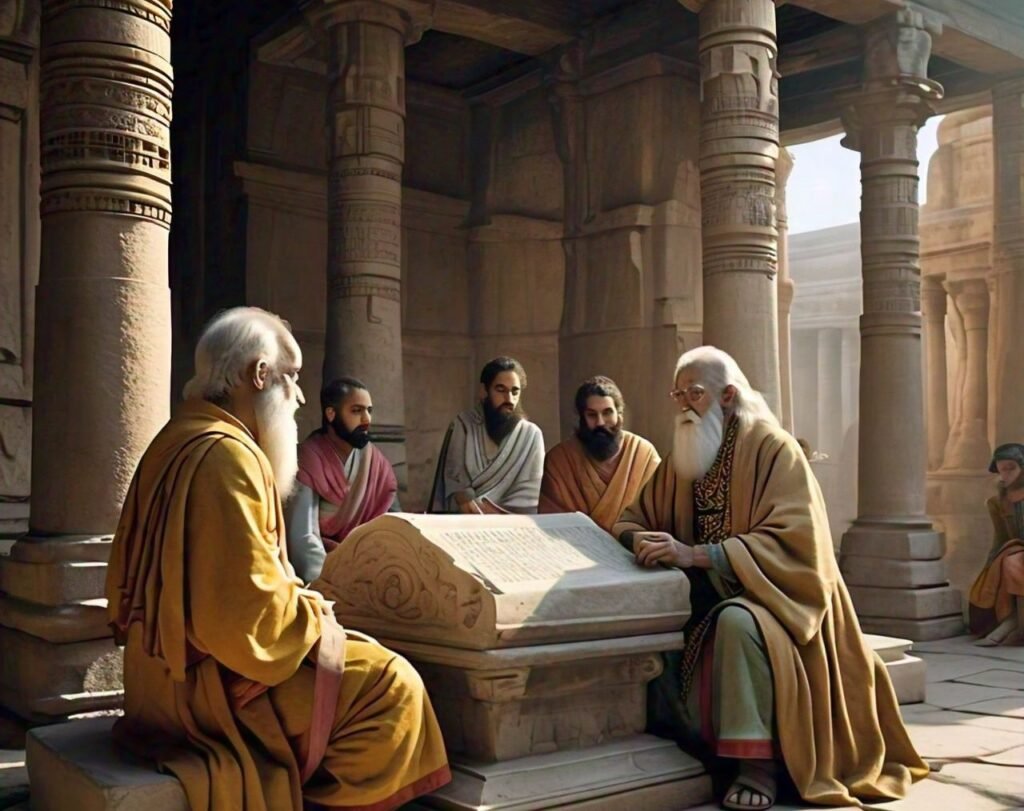Introduction
Society stands on the principles of education, which Molds individuals into citizens equipped with knowledge that prepares them for temporal tribulations. Modern education suppresses creativity and critical thinking by prioritizing uniform examinations and strict curriculms. The examination of ancient civilizations’ educational practices provides valuable information that we can learn from to create an effective and holistic approach to learning today. Those who lived in ancient civilizations such as Egypt, Greece and China had systems of education that did not just enlighten but brought up all rounded people who were useful to their communities. Ancient civilizations education was better than modern education
The Framework of Ancient Education
Education in Ancient Egypt
The primary focus of education in ancient Egypt was directed towards the elite, particularly towards the sons of nobles and priests in order to equip these individuals for roles in administration, governance, and religious leadership.
- Key Features:
- Religious Instruction: Moral values derived from religious texts were emphasized in the relationship between education and religion, which was very close. Students had to learn hieroglyphs which were crucial for conducting administrative matters as well as performing rituals related to religion.
- Practical Skills: In addition, a practical knowledge specific to their future functions was also given. It included fields like mathematics used for tax calculation and engineering used during building projects hence showing a curriculum designed for societal requirements only.
Education in Ancient Greece
Ancient civilizations education was better than modern education in the Western world owes much of its education to ancient Greece especially whereby philosophy, the arts and civic engagement had been emphasized.
- Key Features:
- Socratic Method: It is called after the philosopher Socrates who regarded dialogue and questioning as important. Learners participated in conversations that needed them to be thinking critically alongside their own life examination. Students were able to ponder things rather than receive back the information only.
- Physical Education: However physical activity was an equal part of education in Greece. “Kalokagathia”, which means being morally upright as well as healthy enough physically was more than important. Body building through gymnastics and sports were deemed to be vital as far as mind and body are concerned
Education in Ancient China
The values set forth by Confucius greatly influenced the education of this ancient civilization, emphasizing moral integrity, social harmony, and civic duty.
- Key Features:
- Merit-Based Examination: By establishing the civil service examination system during Han dynasty; it was a time that allowed individuals to have access to government positions based on their hard work and not respect of lineage leading to social mobility through education.
- Classical Texts: In this regard studying classical texts especially those written by Confucius himself formed an important part in academic learning since they contained teachings on ethics, governance and philosophy that served as preparation for students aspiring for careers in scholarship and administration.
The Principles of Ancient Education
Holistic Approach
The important trait of ancient education was that it was holistic, combining different subjects and experiences to form a complete individual.
- Interdisciplinary Learning: Education did not isolate subjects into separate compartments. Students appreciated the linkages among different areas of knowledge as they intertwined subjects such as philosophy, ethics, science, and the arts. For instance, teachers taught mathematics along with astronomy, which was essential for agricultural planning.
- Civic Engagement: There were elements in ancient education that aimed at preparing students for civic life. In an attempt to promote a sense of obligation and participation in social activities, we encouraged public speaking, debate, and involvement in community matters.
Focus on Critical Thinking
Olden school systems valued logical-mindedness ahead of memory based learning; thus making it possible for learners to go through a lot while being in touch with the content.
- Encouraging Inquiry: Students answered questions about existing customs during class hours and also engaged in discussions on societal issues, among other topics. These formulating minds supported inclusion and multiple interpretations for a better comprehension on intricate topics.
- Socratic Dialogue: For example, during Ancient Greece teaching methodologies incorporated conversation. Through such interrogations, educators enabled pupils to find secrets themselves hence owning their studies.
Integration of Arts and Sciences
The old curriculum between arts and sciences was a reflection of its time, as well as a testimony to the significance of both disciplines in ensuring comprehensive education.
- Cultural Literacy: So, students learn poetry, music and arts together with mathematics and science to develop their creativity and be able to appreciate different means of expression. Such an integration developed not only intelligence skills but also emotional and social abilities.
- Balanced Education: The concept of the whole man was central. The ancient Greeks, for example, thought that a genuine citizen had to possess knowledge in various domains which enabled him or her to make substantial contributions towards the society.
Modern Education: A Brief Overview
Structure and Curriculum
Modern education has been characterized by an inflexible framework with standardized curricula, which suppresses creativity and critical reasoning throughout time.
- Compartmentalization: Subjects are often taught in isolation, which results in lack of interdisciplinary links. As a result, learners fail to see the relevance of their studies to actual life scenarios.
- Focus on Testing: Since schools place emphasis on standardised exams, students focus more on memorising rather than understanding, leading to a shallow mastery of subjects. Therefore, students may perform well in exams without fully stimulating themselves during the learning process.
Standardized Testing
This over-reliance on standardized testing in today’s education has far-reaching consequences for teaching and learning.
- Limited Curriculum: Test preparation regularly takes precedence over deeper learning in most educational systems. As a result, teachers may withhold certain topics from students, and may also steer them away from studying subjects that are not included in these assessments.
- Stress and Anxiety: The weight of high-stakes examinations can produce a great deal of pressure among learners. This condition may then hinder their entire educational journey through withdrawal or mental exhaustion as a result of this anxiety.
Comparing Ancient and Modern Education
Student Engagement
| Aspect | Ancient Education | Modern Education |
| Learning Style | Interactive, discussion-based | Passive, lecture-based |
| Student Role | Active participant | Passive recipient |
| Assessment | Continuous evaluation through participation | Emphasis on standardized tests |
Teacher-Student Relationships
Different educational systems have different ways of relating between teachers and their students.
- Ancient Systems: Teachers served more as mentors and guides, establishing personal relationships with their students that were supportive of learning.
- Modern Systems: Teachers frequently transmit information to students in a hierarchical relationship for them to absorb subsequently. Such an approach makes free communication at the educational process difficult, thus making personalized learning experiences impossible.
Learning Environments
Ancient civilizations education was better than modern education and Personalized Technical Atmosphere of Learning Has Evolved.
- Ancient Environment: Learning occurred frequently in public spaces promoting cooperation between learners. This type of setting would build a community towards mutual ownership of knowledge.
- Modern Envionment: Conventional classrooms can sometimes feel lonely because teachers arrange desks in lines that restrict student contact. Such an arrangement can prevent this kind of learning from occurring and also create obstacles to involvement among fellow pupils.
Lessons for Modern Education
Even if the educational systems of ancient times appear far away, they still have a lot to give in the present day. Some ideas have been derived from them:
Promote Critical Thinking
Modern educators can utilize inquiry-based learning so as to make students question things and participate in debates. This way, they may promote a context that fosters curiosity among students thereby enabling them acquire essential critical thinking skills they require to make sense of today’s complicated world.
Integrate Disciplines
Schools can promote integrated programs which coalesce different disciplines so as to offer a broader perspective on knowledge. For instance, an interdisciplinary curriculum merging history with literature together with other artistic aspects may provide the learner’s a complete picture about individual experiences.
Encourage Civic Engagement
Educators should incorporate elements that explain students’ roles as citizens into their teachings. These could comprise engaging in community service activities; discussing topical issues; giving speeches publicly; thereby enhancing social accountability and involvement within it.
Foster Teacher-Student Relationships
Establishing more personalized and caring settings would boost student involvement besides motivation. Mentorship relationships would enable learners feel cherished and understood hence providing them with an affirmative teaching experience.
Conclusion
Many talk about modern systems of education, but they have some shortcomings, such as failing to provide well-rounded development. Early civilizations focused more on emphasizing critical thinking skills than is done now. This research would analyse historical educational practices with the aim of determining their possible contributions towards contemporary educations. IN ancient civilizations education was better than modern education the combination of different fields, inquiry-based learning and establishment of meaningful teacher-student relationships can help in making the process of education to be more effective and attractive.
As we navigate the intricacies of the contemporary world, revisiting the knowledge of our earliest ancestors may help us gain a broader understanding of what we should do regarding learning provisions now. The desire for knowledge must always remain this never-ending pulsating engagement among critical reasoning, imagination, all-inclusive human growth which characterized ancient civilizations’ educational philosophies.
If we take these lessons seriously then we can build an education system that prepares students not just for professions but also as aware and involved citizens amid changing realities. Therefore, returning to the foundation stones used by primitive societies can help individuals who are well-informed, humanly responsive, and self-reliant develop a robust understanding, leading to better qualifications.
Read more about Education on The Experts Tech

